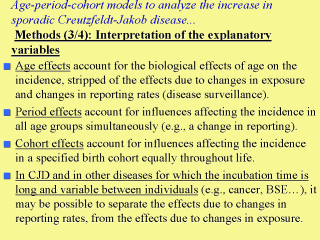| front |1 |2 |3 |4 |5 |6 |7 |8 |9 |10 |11 |12 |13 |14 |15 |16 |17 |review |
 |
Age
effects account for
the biological effects of age on incidence, stripped of the effects
due to changes in exposure, and other changes such as changes in
reporting rates. Period effects account for influences
affecting the incidence in all age groups simultaneously, such as a
change in case definition, or case ascertainment and reporting
(surveillance). Cohort effects account for influences affecting
the incidence in a specified birth cohort equally throughout life.
Because in CJD the
incubation time is long and variable among persons, changes in
exposure to unkown environmental factors are better described as
cohort effects than as period effects. This comes from the fact that
persons born in the same generation are most likely exposed to the
same risks: they have contemporary and similar living habits (e.g.,
eating habits, working conditions). By contrast, if the incubation
time was fixed, changes in exposure among cohorts would appear as
period effects: subjects exposed in 1940 would appear as cases at the
same date (e.g., in 1960 if the incubation was 20 years for everyone).
|